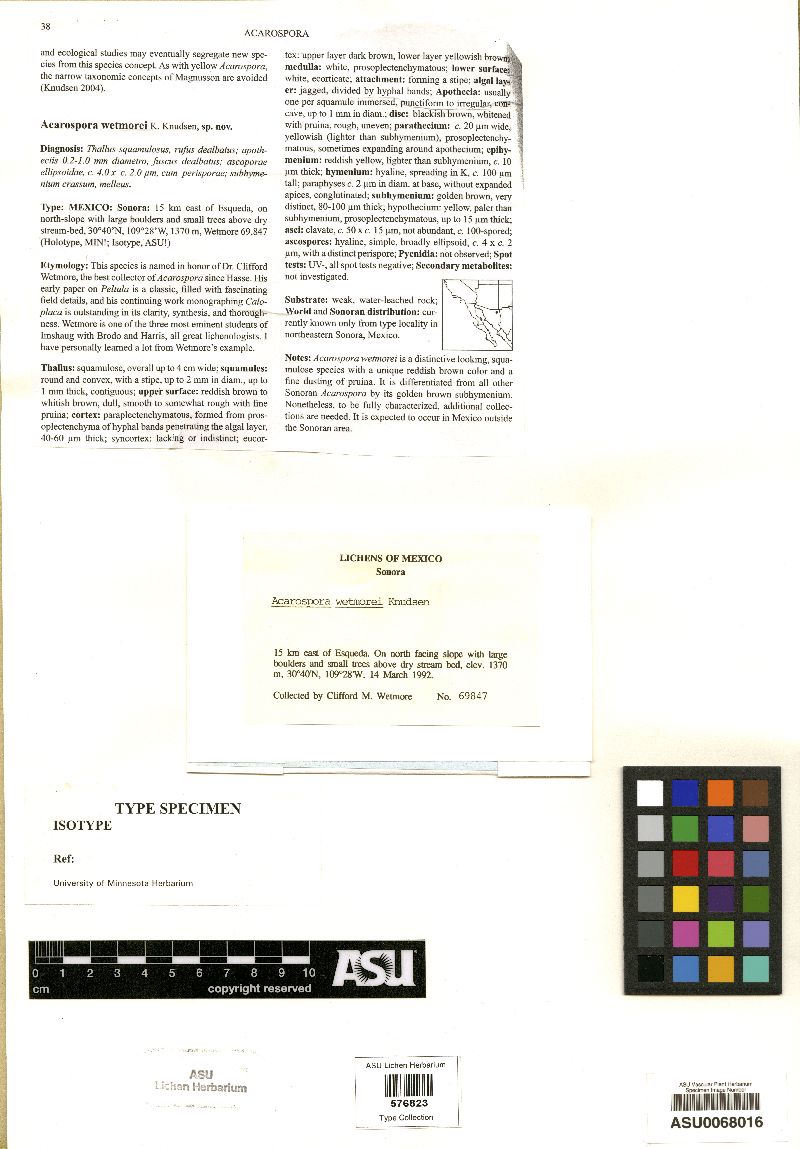
Consortium of Lichen Herbaria
- building a Global Consortium of Bryophytes and Lichens as keystones of cryptobiotic communities -
- Home
- Search
- Images
- Species Checklists
- US States: O-Z >
- US National Parks
- Central America
- South America
- US National Parks
- Southern Subpolar Region
|
|
|
|
Family: Acarosporaceae
|
Nash, T.H., Ryan, B.D., Gries, C., Bungartz, F., (eds.) 2007. Lichen Flora of the Greater Sonoran Desert Region. Vol 3. Thallus: squamulose, overall up to 4 cm wide squamules: round and convex, with a stipe, up to 2 mm in diam., up to 1 mm thick, contiguous upper surface: reddish brown to whitish brown, dull, smooth to somewhat rough with fine pruina cortex: paraplectenchymatous, formed from prosoplectenchyma of hyphal bands penetrating the algal layer, 40-60 µm thick; syncortex: lacking or indistinct; eucortex: upper layer dark brown, lower layer yellowish brown medulla: white, prosoplectenchymatous lower surface: white, ecorticate attachment: forming a stipe algal layer: jagged, divided by hyphal bands Apothecia: usually one per squamule immersed, punctiform to irregular, concave, up to 1 mm in diam. disc: blackish brown, whitened with pruina, rough, uneven parathecium: c. 20 µm wide, yellowish (lighter than subhymenium), prosoplectenchymatous, sometimes expanding around apothecium epihymenium: reddish yellow, lighter than subhymenium, c. 10 µm thick hymenium: hyaline, spreading in K, c. 100 µm tall; paraphyses c. 2 µm in diam. at base, without expanded apices, conglutinated subhymenium: golden brown, very distinct, 80-100 µm thick; hypothecium: yellow, paler than subhymenium, prosoplectenchymatous, up to 15 µm thick asci: clavate, c. 50 x c. 15 µm, not abundant, c. 100-spored ascospores: hyaline, simple, broadly ellipsoid, c. 4 x c. 2 µm, with a distinct perispore Pycnidia: not observed Spot tests: UV-, all spot tests negative Secondary metabolites: not investigated. Substrate: weak, water-leached rock Sonoran distribution: currently known only from type locality in northeastern Sonora, Mexico. Notes: Acarospora wetmorei is a distinctive looking, squamulose species with a unique reddish brown color and a fine dusting of pruina. It is differentiated from all other Sonoran Acarospora by its golden brown subhymenium. Nonetheless, to be fully characterized, additional collections are needed. It is expected to occur in Mexico outside the Sonoran area. |
Powered by Symbiota











